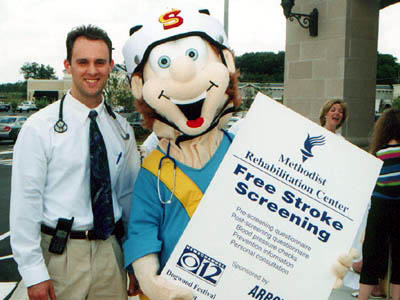JACKSON, Miss.—Physicians at Methodist Rehabilitation Center want Mississippians to know the risk factors and warning signs of stroke—the third leading cause of death and the leading cause of serious, long-term disability in the state.
Coinciding with national stroke awareness month, nurses and physicians at Methodist Rehab will offer two free stroke screenings in May. The first is set for May 8 at Dogwood Festival Market in Flowood from 11 a.m.-1 p.m. and the second is May 29 from 8-10 a.m at Northpark Mall. Participants will learn the warning signs and symptoms of stroke and have their blood pressure checked by nurses who staff the Jackson hospital’s comprehensive stroke program. They’ll also learn ways to prevent a stroke.
“Heredity, poor diets and unhealthy habits combine to make stroke a major health risk in Mississippi,” said Dr. Rahul Vohra, the Jackson hospital’s medical director. Dr. Vohra says awareness of warning signs, advances in drug treatments and comprehensive rehabilitation are essential to preventing or recovering from a stroke.
"Our state is right in the middle of the so-called stroke belt," said Dr. Vohra. “Mississippi and the other southeastern states have a higher death rate due to stroke than any other region of the country.”
A stroke or brain attack is caused by a sudden decrease in the flow of blood to the brain. When blood cannot reach the brain, brain cells are deprived of oxygen and die. Functions normally controlled by the damaged area of the brain are then impaired.
“It is critical that everyone know the risk factors and warning signs of stroke and that they seek treatment immediately in an emergency room if they experience any of the symptoms,” said Dr. James L. Williams, a Methodist Rehab physician who also treats stoke patients. “People need to think of a stroke as they do a heart attack—every second counts. It is critical that they call 911 and get to an ER as quickly as possible.”
Patients who are evaluated within three hours of the onset of symptoms may be candidates for treatment with tissue plasminogen activator (t-PA), a clot-busting drug which opens the clots that cause stroke.
Risk factors include:
- High blood pressure
- High fat diets
- Cigarette smoking
- Previous stroke
- Heart disease
- Diabetes
- Carotid artery disease
Heavy drinking of alcohol especially "binge drinking" has also been associated with stroke. African Americans have approximately a 60 percent higher risk of stroke than whites and men have a greater risk of stroke than women. A person's stroke risk doubles each decade after age 55.
Stroke warning signs include:
- Weakness or numbness on one side of the body
- Sudden imbalance
- Sudden difficulty speaking or understanding speech
- Sudden difficulty seeing in one eye
- Sudden and severe headache that is unusual for the patient
“Some strokes are preceded by transient ischemic attacks (TIAs),” said Dr. Vohra. “TIAs occur when there is a temporary interruption of blood to the brain. The symptoms for TIAs are the same as those for stroke, but they go away within minutes. Anyone experiencing a TIA should seek medical treatment immediately in an emergency room.
“There’s much that we can all do to prevent stoke,” added Dr. Williams. “Everyone needs to control their blood pressure, stop smoking, maintain a healthy weight, eat a healthier diet and lower their cholesterol level. These little lifestyle changes should start at an early age since the processes that lead to stroke later in life begin in childhood.”
For those who do suffer a stroke, physical rehabilitation is essential for a successful recovery. “For a stroke survivor, the goal of rehabilitation is to be as independent and productive as possible,” Dr. Williams said.
Successful rehabilitation depends on the extent of the injury, the patient’s attitude, the support of family and friends and, most importantly, the experience and skill level of the rehabilitation team.
“Methodist Rehab offers the state’s only comprehensive stroke rehabilitation program,” Dr. Vohra said. “And that’s important because here each patient’s care is coordinated between different disciplines like physical, speech and occupational therapy. Our physicians, nurses and therapists have unparalleled experience helping stroke patients recover.”
The goal at MRC and at other comprehensive stroke injury centers in other states is to reduce dependence and improve physical abilities. Often old skills have been lost and need to be relearned.
“Recovery after a stroke can be seen up to 18 months after the event,” said Dr. Williams. “It can be a long road back. That’s why it is so important that each of us to do all we can to prevent a stroke by living a healthy life and paying attention to the warning signs our bodies send us. For those who do suffer stroke, rehabilitation is essential. The earlier we see recovery from a patient, the more likely we are to see continued progress.”

